14 Preparations for a safe and respectful Colt Starting
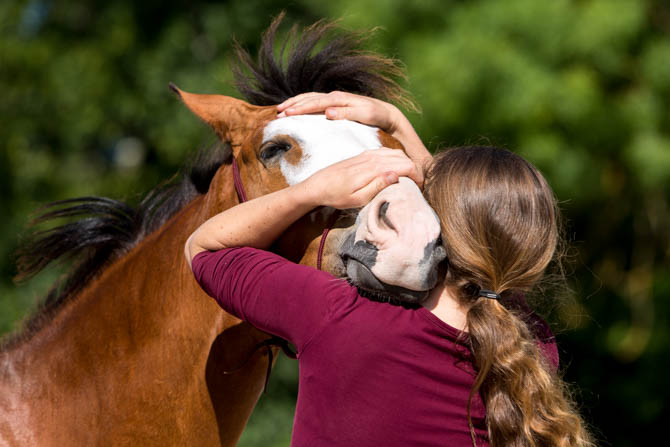
Every young future riding horse needs to be started at one point. During the Colt Start we ask the horse to accept three things which are completely against his nature as a prey animal:
- A predator is sitting on his back with a saddle and a cinch which is compressing his rib cage
- To give up control over the direction he wants to go
- To give up control over the gait or speed he wants to travel with
If these things are not well explained to the horse, most probably he will get afraid and start to fight for his life. His flight instincts are triggered. The horse will try to get rid of the human by bucking, rearing and bolting. This situation means not only deep emotional trouble for the horse, for most of us it wouldn’t be safe at all.
I see horses as friends and as partners. I would love it if the time we spend together brings happiness not just to me, but for both of us. As I do with every other friend, I respect them, I care for them and I watch out for them. I don’t want them to be in emotional trouble. This results in the question:
How can we prepare our horse for Colt Starting that he doesn’t get in trouble and we can stay safe?
A Colt Start consists of 5 stages:
- Accept the cinch
- Accept the saddle
- Accept the rider
- Respect the directions of the rider
- Accept and understand the bit (if wanted)
There are a lot of things we can prepare already long before on the ground. By explaining to the horse what we expect of him, I can effectively prepare him to understand these 5 stages more easily and with less stress. It should be a positive experience for the horse. In the end, the colt start is not just something in a horse’s life. It will colour its perception of the rider for the rest of his life.
-
"If I had a horse buck with me now, I’m a little disappointed. It’s not the end of the world, but I’m a little disappointed if I couldn’t keep the horse out of trouble. Whereas it used to be a source of pride and now it’s sort of a source of shame if I let the horse get that lost."Colt Starting Expert
- 1
There are 4 groups of exercises which will help the horse to understand his future job:
(You can click on the exercises to jump forward to the explanation)
1. Establish understanding of basic communication
The Touch It Game
Easy Obstacles
2. Exercises to gain his willingness to let me control his gaits—Stop and Go
Good girl/good boy stop
Question—cone, controlling gait on a circle
Backing up through pressure on the nose
Tea bag back up.
Lateral flexion
3. Exercises to gain his willingness to let me control his direction of travel
Yielding the shoulder
Yielding the Hindquarters
Yielding Sideways
Figure of 8 with feel on the halter
4. Exercises to help him to accept the rider with confidence
Ball on the back
Confidence with the flag
Come to the mounting block—the hugging station
When I have issues with any of these things already on the ground, the problem will be worse once I am on the horses back. I am creating a clean slate, a common ground of communication to reduce opposition reflexes and instinctive behaviour to a minimum.
It is not about doing these exercises until the horse does them to perfection. It is much more about achieving a certain frame of mind—connection, communication and confidence in me as the leader.
Establish First Communication
The foundation of everything is communication. Before teaching any task, I have to show to the horse that a dialogue is possible and wanted. Many horses didn’t experience yet that humans can listen and answer—and that they, in return, can listen, answer and hit a jackpot!
-
"You might wonder how to control a young horse without a bit. The key is to educate and form a strong connection to the horse - this will work better than any mechanical tool."
- 1
Read more about How you can Establish a Dialog with your Horse here.
The Touch It Game
To achieve this, I use a very simple game—the Touch-it Game. The key to this game is the horse’s natural curiosity. I will put all sorts of interesting objects into the arena which will draw the horses curiosity. I will ask the horse to go and check out an object. Once it does and puts the nose on it, I reward—it hit a jackpot.
I will always use the same word, tone of voice, sometimes even food reward—it depends on the horse. The horse will learn a specific word which it connects with having done something right. It will start to ask questions to me by looking at me with ears forward. A dialogue has started.
With this simple exercise, I can start first communication about going forwards (to the next object), stopping (to explore the object) and changing directions. The object gives everything a purpose and the horse will be less inclined to show opposition reflex.
At this point, it really isn’t about perfection. The goal is for the horse to learn that my requests have a specific purpose and that he can always find a reward in the end. It will start to look for the jackpot.

The Touch-it Game helps to start a mutual dialog
Easy Obstacles
Once this is working well, I introduce easy obstacles. Asking the horse to navigate over ground poles, a little jump, a tarp or stepping on a pedestal will help me to develop this dialog further. Later I can use these obstacles to test the horse’s acceptance of the cinch and the saddle.
Most horses feel very restricted in their movement once cinched up. The obstacles will help me to show the horse that it can still do everything as before once it is wearing cinch and saddle.
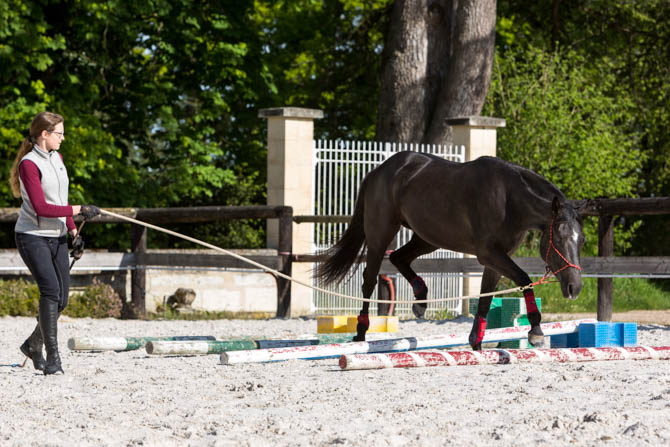
Asking to cross easy obstacles like ground poles will intensify the mutual dialog
Exercises to gain his willingness to let me control his gaits—Stop and Go
Through the touch-it game, the horse already has a first idea about answering correctly to forward and stopping. This is the foundation for the following 5 exercises. Now it is time to be a bit more specific about the horse's impulsion.
Read the detailed description about How to gain Control over your Horses Gaits Part I - here
Good girl/good boy stop
Wouldn’t it be great if you could smile and just relax and your horse would stop? With the good girl/boy stop, the horse learns to quit doing whatever it was busy doing and melt to a stop to get the reward. It is a combination of voice cue and relaxing my energy. In my experience, this is a very powerful stop button. No need to pull on the reins once I am riding the horse. I am teaching to the horse to relax to a full stop by praise.
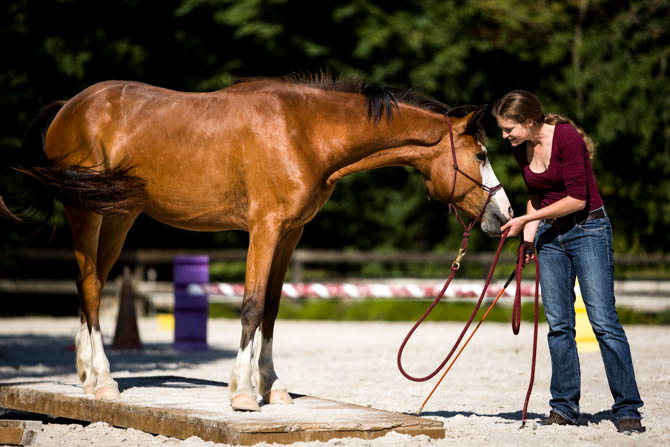
The horse learns that by targeted reward that it hit a Jackpot and can stop doing whatever it was busy doing.
Question—cone, controlling gait on a circle
Many young horses have difficulty to find a reason for running in circles. Instead, they get all creative about it—egg shape, square, with changes of direction… By simply placing one cone on the circle, I can add a lot of focus and purpose. At this cone, I will ask for transitions upwards and downwards. The horse has the chance to anticipate a request and make himself mentally ready. Very soon he will even show off how clever he is—reason for praise and to make the horse feel good about himself.
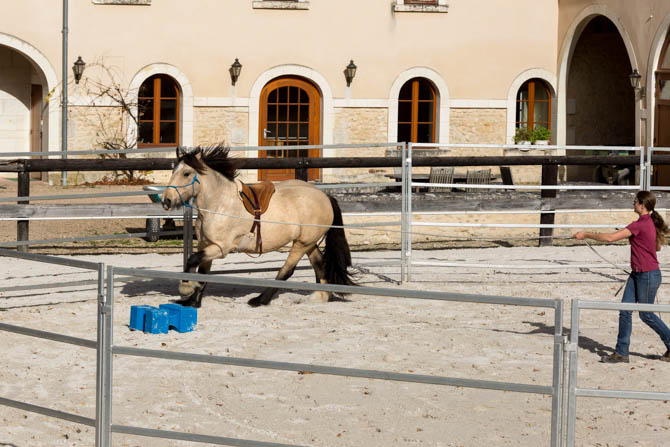
The Question-Cone Game adds purpose to Circles
Backing up through pressure on the nose
I teach the horse to yield backwards by applying pressure with my hand (ideally not more than 50 g) on the back of his nose.
The better the horse knows how to back up willingly and softly, the better it is prepared to understand the action of the reins once riding. This prepares all downwards transitions. This exercise is especially important when starting horses bitless.
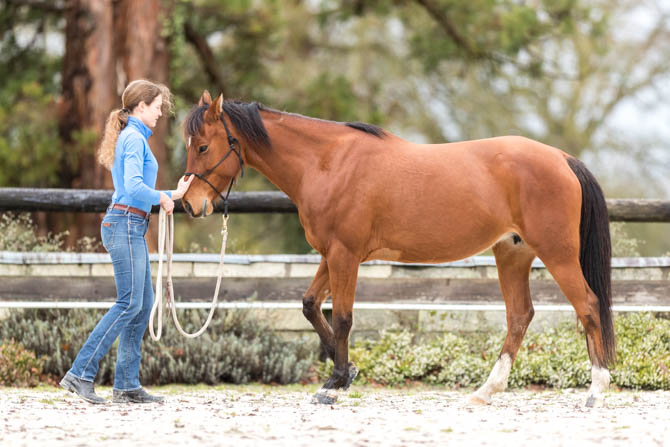
Teaching the horse to back up by the nose will help the horse to understand downwards transitions and stopping once riding
Tea bag back up
The horse learns to back up lightly by bouncing the rope or rein up and down to move the halter. The movement is very similar to that when dipping a tea bag—that’s where the name comes from.
I start all horses in a simple knot halter—they are designed for riding with loose reins. By teaching the horse to back up by this rhythmic pressure, it prepares him well to understand all downwards transitions, stopping and backing up while using one rein.
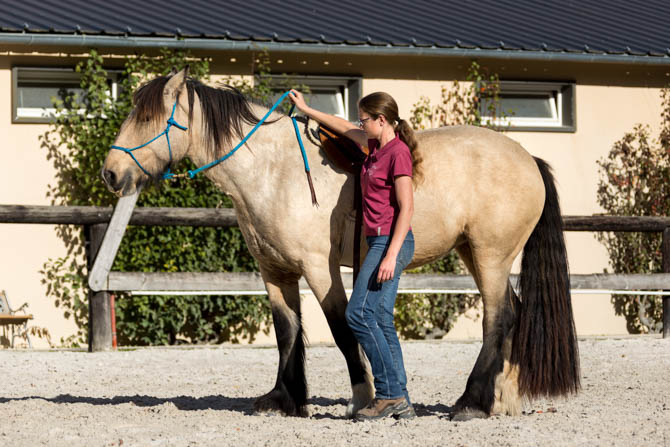
The Tea-Bag back up for soft and easy downwards transitions
Lateral flexion
The horse learns to bend his neck laterally by following the feel (steady pressure) of halter and lead rope—later the reins. This will be my emergency brake. Trying to stop an out of control horse by pulling on two reins is usually not very effective.
When I bend the horse with one rein, his hind legs have to cross and he can no longer run. I can also use Lateral Flexion to reconnect the horse with me in case it got worried. As the horse can see the rider from this position, it is easy to refocus the horse's mind.
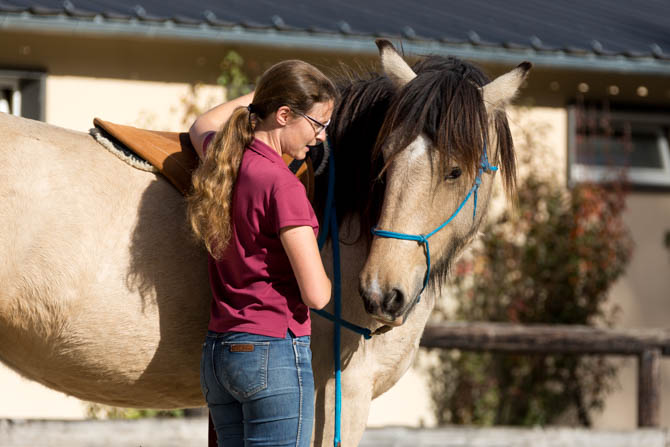
Lateral Flexion for emergency control and to re-connect
Exercises to gain his willingness to let me control his direction of travel
Through the Touch-It game I can already send my horse off to the left or the right, ideally both at the walk and trot. The following 4 exercises will help to refine the horses understanding about direction.
Yielding the shoulder
To make a turn, the horse has to mobilize the shoulders. I teach the horse on the ground to yield the shoulders to light pressure of my hand in the cinch area. This will prepare it to better understand the aids of the rider’s legs. Later on, this can turn into a spin, shoulder in or even the pirouette.
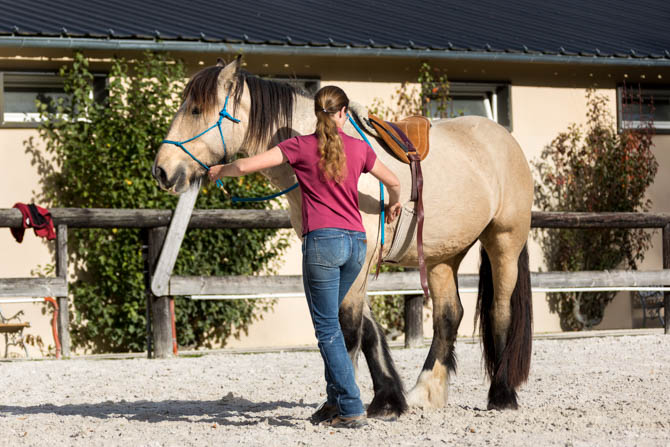
Yielding the Shoulders for turning and easier understanding of the riders leg
Yielding the Hindquarters
The horse learns to yield his hindquarters by responding to light steady pressure. Being able to mobilize the hindquarters and ask the legs to cross under the body serves two purposes: at first, it serves to control and later on, I can use it to develop lateral moves.
A horse can’t run, rear or buck with his legs crossed. It teaches the horse to allow communication about each of his legs and to be supple.
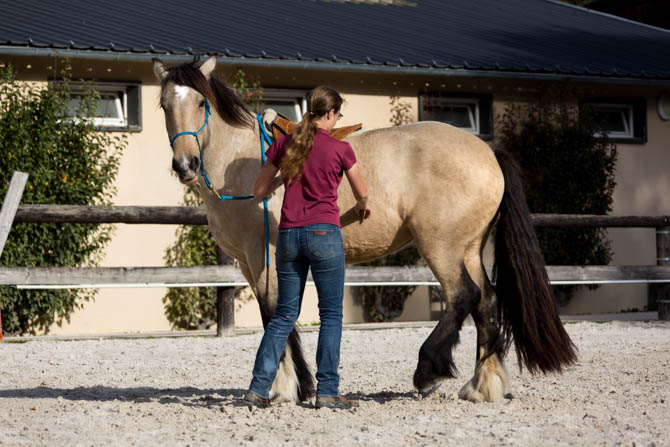
Yielding the Hindquarters for control and later to develop lateral moves
Yielding Sideways
I like to teach horses on the ground to yield sideways by light pressure against the ribs right where my leg would be. The easier I can yield a horse in all directions, the more communication and control I will have.

The aids of the legs can be very well taught on the ground - sideways
Figure of 8 with feel on the halter
The horse learns to follow the feel of the halter when guiding it in a figure of eight. I do this exercise first at a walk, bu. I see best results at the trot. Some horses have difficulty to accept that the rider determines where to go and like to argue about it. This exercise allows me not only to explain direction but also to work through resistance.
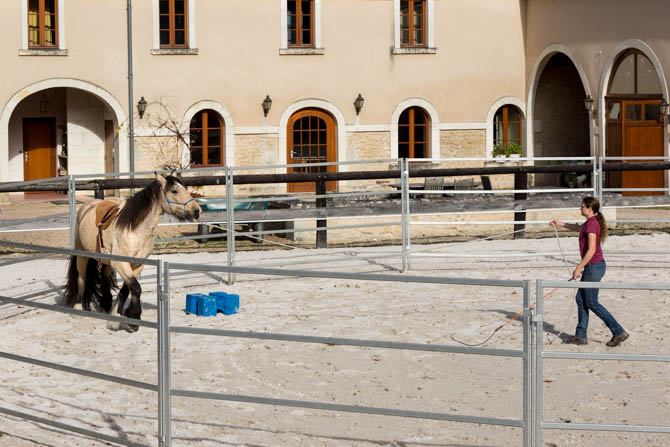
The Figure of 8 teaches the horse to follow the feel of the leadrope with his nose and feet
Exercises to help him to accept the rider with confidence
When accepting the rider on the back, the horse needs to have a high level of confidence in several different areas:
- in you the future rider
- objects above him
- Confidence with sudden movements and noises
Ball on the back
This friendly game will increase the horses level of confidence about objects and movements on top of his body. If a young horse can accept a ball with confidence on his back, it will most probably also accept the rider with ease.
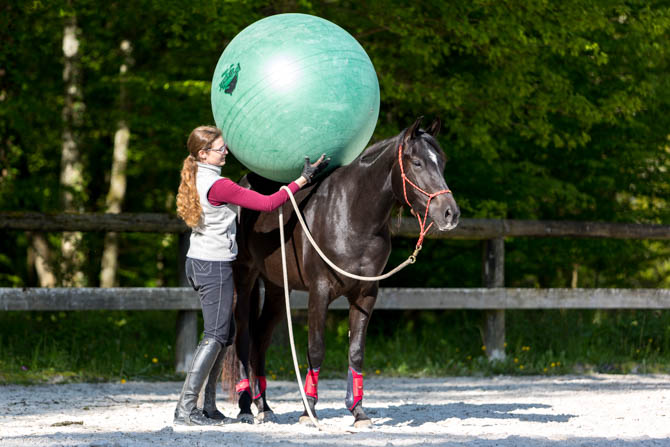
Get confident with objects above - the ball on the back
Confidence with the flag
This is a friendly game which will help the horse to become more confident with sudden noises and movements. Some young horses react very sensitive to movements they can see in the corner of their eye or on top of them—for example, the rider’s hands or legs. Or just imagine you are wearing a noisy rain jacket for the first time on your colt. Getting a horse to accept the plastic flag flapping around and on his body with confidence will ultimately increase his complete level of confidence.
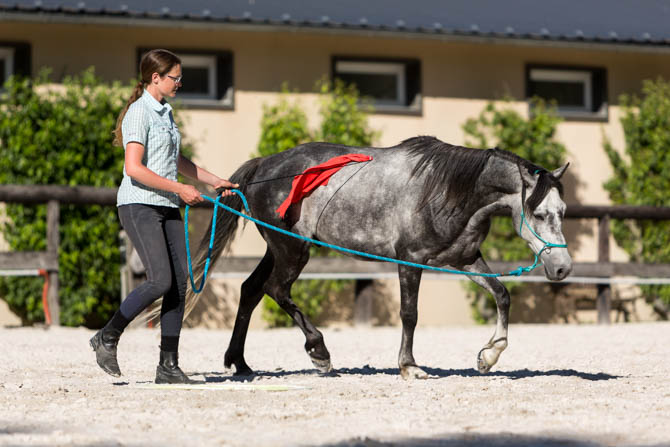
When the horse can accept the flag touching his body, his confidence in general will grow.
Come to the mounting block—the hugging station
The horse learns how to position himself at the mounting block. It already learns long before accepting the rider on his back how to stand still at the mounting block. I also like to call it the hugging station. My goal is for the horse to fall in love with that place.
While standing on an object which I will use later for mounting, I ask the horse to step closer until I can put my arm over his withers. I usually just stand there for a while and hang out with the horse. Later on, I usually never have issues with patience at the mounting block.
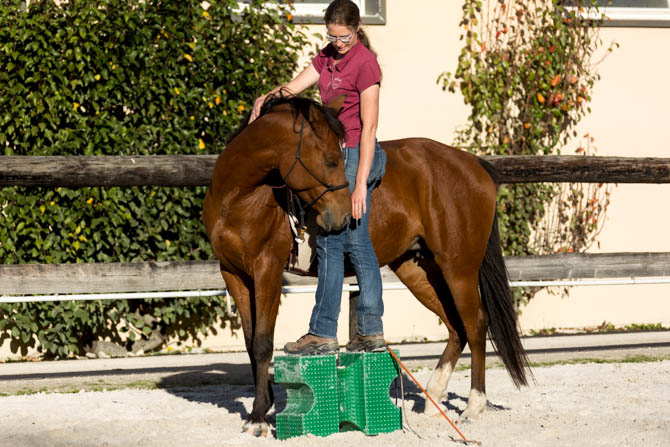
Teach the horse to fall in love with the mounting block: the hugging station
Ready for the Next Steps
With all these preparations done, your horse is ready for the next steps in the colt starting process: to accept the cinch, then the saddle and finally the rider. Your horse is now ready to start his life as a riding horse. By now your horse finds it fun to work with you, is open to new experiences and feels successful as a learner. Having done these preparations, you made sure to do your best in treating your horse like you would treat a friend—with support and respect.

